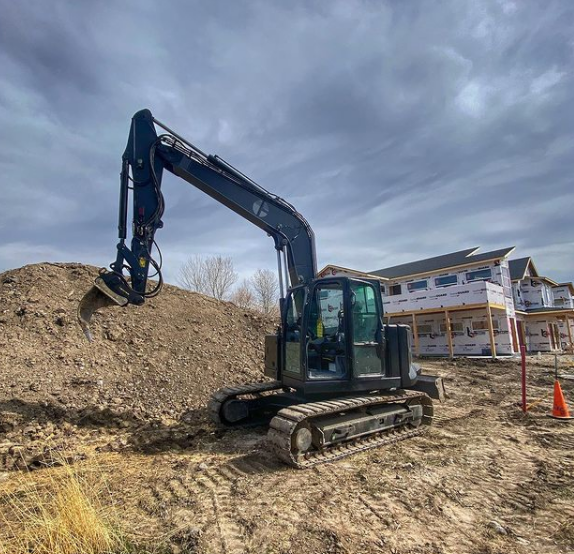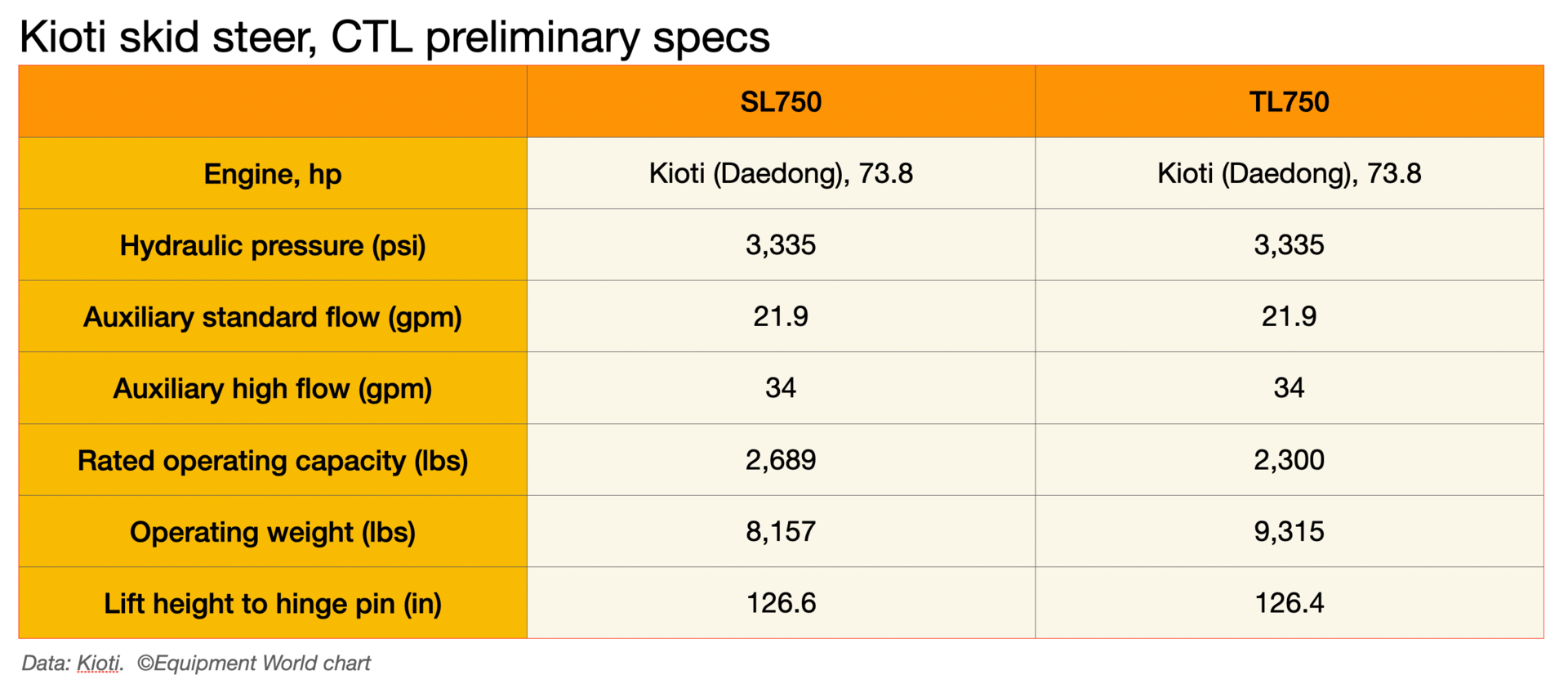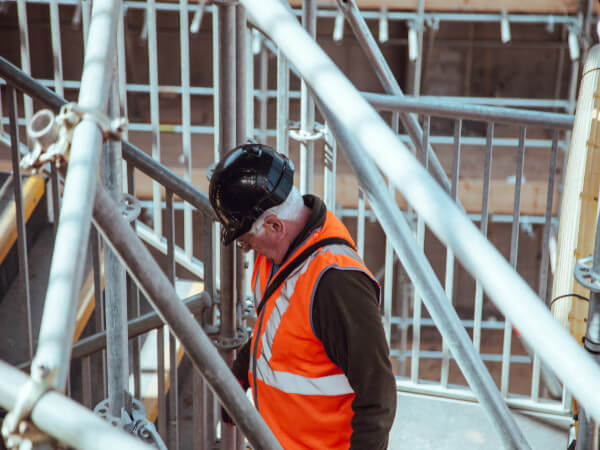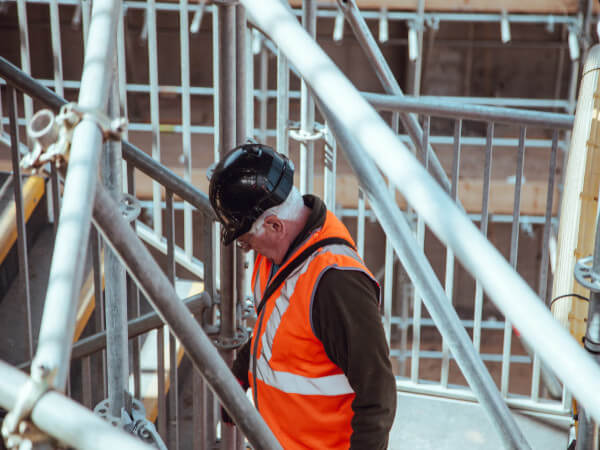Home » Construction Management (Page 3)
Category Archives: Construction Management
How Custom-Painted Equipment Can Boost Your Marketing
Construction equipment gets its fair share of head turns while operating or parked on the side of the road. But custom-painted equipment? Those are real neck breakers.
Not only do custom-painted machines look slick, owners say there are numerous marketing benefits too.
Having a professionally branded fleet with a unique color scheme is like having a billboard at every job site. The use of the right color can boost your brand recognition by 80 percent, according to a 2019 survey released by Reboot.
We talked to several contractors with custom-painted fleets to see how the unique paint job has given them an edge.
Here areareas where they’ve seen results, and a few drawbacks to consider:

Marty Lenum’s bright red equipment is hard to miss.Dirt Monkey Excavating
Increased Brand Awareness
Painting your fleet a custom color can create some serious buzz in your community and attract potential customers. With word of mouth still considered a top marketing tactic, a flashy fleet can help increase the frequency of organic conversations about your company.
“Everyone knows it’s us at the job sites,” says Marty Lenum, owner of Dirt Monkey Excavating based in Cashton, Wisconsin. “Branding is a top priority when it comes to building our business, and our fleet is a critical part of that.”
Lenum’s dealer Fabick CAT coordinates the painting of his signature red equipment.

“Why be like everybody else,” says Kimo Clark. “Make people curious about your brand.”Truth Excavation
Stretch Your Marketing Dollar
Is your brand the opening act or the headliner? Making your brand the star of the show helps your marketing dollars go further. Billboards and digital ads have a shelf life, but painted equipment is permanent.
“When I was in a band, I learned that gaining a following is all about self-promotion. I took that experience into the heavy equipment world because nobody was really doing branding or creative videos around 2012,” says Kimo Clark, owner of Maui, Hawaii-based Truth Excavation.
“As soon as I get new equipment, I take the decals off, paint it green and put our name on it. I consider it a marketing expense. A memorable company name paired with painted machines and great photo and video content makes a super-brand.”
In addition to painting your fleet, Clark says, look at the content being created in other industries, like surfing and skateboarding, for inspiration. Marketing for your construction business doesn’t have to be stuffy and boring. Make it fun and memorable.

Stop them in their feed. Custom-painted equipment can help catch the attention of your future workforce on Instagram or TikTok, says Dane Cotten.DC Excavation
ttract New Employees
Custom-painted equipment may also garner the attention of your future workforce. A millennial himself, Dane Cotten, owner of Bozeman, Montana-based DC Excavation, knows that branding, storytelling and a solid digital presence are critical factors in attracting the tech-savvy younger generation. Case in point, a video showing off his newly painted D6 received tens of thousands of views and likes on Instagram alone.
“Our black equipment with the old school CAT decals is a differentiator,” says Cotten. “It has helped us attract employees. Operators want to run the latest equipment, and the unique look doesn’t hurt either. Anybody can have equipment, but custom-painted equipment gets recognized and remembered.”
Cotten thinks more OEMs should offer factory-direct custom paint options due to the increasing importance of branding in the industry.
The Downsides to Painting Your Equipment
While none of the contractors we spoke to listed any drawbacks, here are a few you may want to consider.
Additional Expense
A custom paint job will set you back several thousand dollars. Owners should weigh if the cost is worth the potential benefits.
Issues When Selling
When selling or trading in equipment, some buyers may ask you to repaint the machine to factory colors. Just like that, more money has walked out the door.
Quality Control
Not all paint jobs are created equal. The technology and materials used to paint the machine by a third party may not be to the same quality standards as the factory. Premature peeling and chipping may occur.
Product Roundup: 20% More Run Time on Generac’s New Light Tower
LEDs boost light levels and run time on Generac’s new light tower
Generac announced a new mobile light tower, the GLT with LED light fixtures that offers up to 20 percent longer run time than previous models. The GLT’s flexible platform design enables you to use it as a mobile or stationary light tower.
With 48 gallons of fuel, the GLT will give you 200 hours of run time. The four Generac G4 LED lights provide maximum illumination while consuming less power to give you 200 hours of run time on a full (48-gallon) tank of fuel. The high-efficiency LED lights also allow for faster start-ups with no waiting for warm up or cool down.
A steel enclosure wraps around the unit to create an integrated fuel containment system that holds up to 110% of the unit’s fluids and thus prevents fluid spills. And the mast is available with hydraulic, electric or manual options. The GLT will be available for ordering in the first quarter of 2022.

The DeWalt Power Stack delivers 50-percent more power in a 25-percent smaller footprint.DeWalt
Smaller, more powerful and it fits on your old tools
The new 20-volt Max Power Stack is DeWalt’s most powerful, compact and lightweight lithium-ion battery platform to date. According to the company, it has twice the power and a 25 percent smaller footprint compared to DeWalt 2 amp-hour compact batteries. It is designed to fit with any of DeWalt’s 20-volt Max tools and chargers, and it features an impact-resistant, over-molded base with a non-marring material. The charger is also compatible with all DeWalt 12-volt Max, 20-volt Max and Flexvolt Batteries.

“Access Your World” provides JLG customers with information about products and services at any time and at their own pace.JLG
JLG adds new virtual-reality scenario to training platform
Virtual reality is a great way to train new operators, especially on machines where mistakes can be costly. JLG has been compiling a portfolio of telehandler training scenarios in its “Access Your World” platform, the latest of which is an indoor/outdoor retail complex that showcases detailed, 3-D equipment models being used in multiple stages of construction and experience using JLG equipment in these applications.
The company also has an augmented-reality app that includes five tools:
· Machine Visualization
· Kit visualization
· Operation guidance
· Decal viewer
· Inspection assistance
Previous virtual reality scenarios include maintenance work, steel erection, and fit and finish work inside a stadium. You can read more about those here: Product Briefs: Explore Virtual Lift Scenarios with JLG’s Access Your World.
ccess tight spaces up high with Skyjack’s new XStep
In places where the full platform of your scissor lift is blocked from going higher, Skyjack’s XStep enables you to get 19 inches of additional work height. XStep is mounted on the mid-rail of the scissor lift. The top rail design and height provide operators with the same degree of security as a conventional platform, and the base swings down to save space when not in use. The XStep is retrofittable to previous Skyjack models without the need for tools, and one person can do the job. It is also available as a factor fit or field install option. XStep is the latest addition to Skyjack’s Accessoryzers line of accessories.

Users can see the real-time status of their Pettibone telehandler with X-Command.Pettibone
Pettibone telematics gives you real-time insights into machine health
A new telematics program from Pettibone called X-Command is designed for the company’s X-series telehandlers, Cary-Lift pipe and pole handlers, and Speed Swing rail maintenance machines. With the telematics you get real-time access to data such as machine location, fuel use, diesel exhaust fluid level, and battery voltage.
The information allows superintendents and maintenance personnel to diagnose machine performance and issues to increase uptime and reduce emergency repairs in the field. X-Command comes standard for two years on new Pettibone X-Series Extendo and Traverse telehandlers, and it is also available as a retrofit for existing X-Series models in the field. The system is optional on new sales of Cary-Lift material handlers and on Speed Swing.
Did you miss our previous article…
https://constructionosa.org/?p=828
Hitachi Rolls Out ZW100-6 Wheel Loader for Lighter Jobs

Hitachi’s new ZW100-6 is a small, yet powerful wheel loader well-suited for lighter applications, including landscaping, excavation, earthmoving and utility work.
With an operating weight of 17,042 pounds, the compact model is powered by a Deutz engine providing 101 horsepower and 9,680 pounds of breakout force. The engine meets Tier 4 Final emissions requirements through a selective catalytic reduction system that injects urea into exhaust gas to reduce nitrous-oxide from emissions and eliminates the need for a diesel particulate filter. Hitachi says the engine also features a quick power switch that increases engine output when required or when driving uphill.
Bucket capacity on the ZW100-6 is 1.4 cubic yards, and the machine has a maximum hinge pin height of 11 feet 6 inches.
A hydrostatic transmission control system makes the machine easier to maneuver. Operators can choose between two work modes based on the task and terrain. The oscillating rear axle provides more stability and traction than loaders with a fixed axle, the company says. When working in wet or slippery conditions, torque proportioning differentials help avoid tire slippage, preventing wear and fuel waste. The ride-control feature minimizes machine pitching for a smoother ride and to reduce bucket material spillage.
Compared to previous models, the ZW100-6 uses 6% less fuel during V-shape loading and 19% less fuel during traveling operations. Fuel waste is further reduced through the standard auto idle shutdown.
The ZW100-6 offers a clear view of the jobsite with 360-degree visibility from the cab. The repositioned muffler and air intake improves visibility out the back window. The curved engine hood further enhances visibility and safety. Improved insulation in the cab reduces noise levels, making for a quieter work environment.
An easy-to-open wide engine cover allows for easy access for ground-level maintenance. The engine air filter has been relocated to the rear of the engine compartment. The reinforced front frame features heavy-duty axles, designed in-house for increased durability. An optional belly guard can be added to protect the powertrain and driveshaft.
The ZW100-6 is also equipped with Hitachi’s Global e-Service for 24/7 remote monitoring of machine performance. The company’s ConSite program sends automated monthly service reports on daily working hours and fuel consumption data; statistics on the operating mode ratio, plus a comparison for fuel consumption/efficiency, and emissions.
After adding the new ZW100-6, the Hitachi ZW-6 wheel loader lineup now includes 15 models.
Did you miss our previous article…
https://constructionosa.org/?p=815
Striking Deere Workers to Vote on New Deal

If UAW workers at 12 plants in Iowa, Illinois and Kansas agree to a new six-year contract with Deere & Company, the strike that had the potential to create even more supply-chain woes for construction equipment customers may be at an end.
Picketers will remain at facilities until union members give their approval to any agreement, a vote that the Waterloo Courier in Waterloo, Iowa, says will take place Tuesday.
If the new deal is ratified by the UAW membership, it would mean that the two-week strike that began on Oct. 14 would be over much quicker than the last time Deere workers walked the picket line in 1986. That strike lasted more than five months.
The Waterloo paper says the proposed contract includes a 10% increase in the first year, and 5% raises in the contract’s third and fifth years. In addition, the proposal includes 3% lump sums in years two, four and six of the contract along with cost-of-living adjustments.
UAW members would also get a ratification bonus of $8,500 and no increase in health insurance cost. New hires would receive coverage after 30 days, and members would receive two weeks of full-paid parental leave, vision and autism care coverage, says the paper, citing the UAW Local 838’s Facebook page.
The new deal means that entry-level Deere union employees would see an immediate increase in hourly wages from $20.12 to $22.13, says the Des Moines Register. Deere will reinstate quarterly cost-of-living adjustments that workers lost in their 2015 contract. Throughout the life of the six-year contract, the UAW expects workers to receive a 30% increase in wages; the contract ends in 2027.
Deere also added lump-sum payments for future retired employees, says the Des Moines paper. Employees who stay with the company for 10 to 24 years would receive $37,500; workers who stay beyond that would get $50,000. Deere would also give employees an extra $2,000 for each year worked at the company.
Did you miss our previous article…
https://constructionosa.org/?p=722
Sneak Peek: Kioti Lifts the Veil on Its Coming Compact Equipment Line
At the recent GIE + Expo, Kioti Tractor took the wraps off its new skid steer loader, which it expects to have in dealers’ hands by the second half of next year.
Along with a coming compact track loader that it also announced at its dealer meeting late last year, the skid steer represents Kioti’s coming foray into compact equipment. The two machines will expand its equipment offering beyond the utility tractors, UTVs and lawn mowers now on the Daedong-USA subsidiary’s product list.
Kioti also indicates that a compact excavator may be forthcoming. “We have a roadmap and mini excavators are something we’re looking at as well as other platforms that are hot right now,” says Greg Bibee, Kioti director of strategic sales and marketing, in an interview with Equipment World.
Kioti has hired Jason Boerger, formerly Bobcat’s excavator marketing manager, as its compact construction product manager.
“Having Jason on board is part of our journey into more compact construction equipment and building the team around it,” Bibee says. “This goes beyond just the equipment we are going to launch initially.”
Initial products
Kioti says it’s still finalizing the base and optional features of the SL750 skid steer and TL750 CTL, which will be launched in “a couple of different versions,” says Bibee.
As indicated in last year’s release, the SL750 and TL750 (both model names are still preliminary, by the way) will be powered by a 74-horsepower Kioti engine, which comes from the firm’s South Korean parent Daedong.
“It will be a similar engine to what we use in our RX Series of tractors,” Bibee says.
The initial versions will have full cabs although an ROPs option is likely. “We’re still evaluating the potential take rates of certain features and options,” says Boerger. The entry door on the vertical-lift units will slide up instead of opening to the side.
Additional recently released specs include a hydraulic pressure of 3,335 psi, auxiliary standard hydraulic flow of 21.9 gallons per minuteand high flow for both machines of 34 gpm. (Additional specs are in the chart below the article.)
Kioti cautions that the second half of 2022 timeline for these products is also dependent on global supply chains settling down to at least a somewhat normal delivery schedule. Both machines will be manufactured in South Korea.
Why enter a crowded market?

The Kioti SL750 skid steer and TL750 compact track loader.Kioti Tractor
Bibee says Kioti gets asked this question a lot. The simple answer is that it’s the logical next step in the company’s growth. The company entered the U.S. market in 1986, offering under-100-horsepower utility tractors. It added utility vehicles in 2015 and introduced a zero-turn mower line in 2019.
“We’re looking at both our dealer network and current customer base and seeing what products would bring new customers into their stores,” Bibee says. “For our current customers, it gives them more types of equipment.”
Bibee says there are similarities with the company’s recent foray into turf care and the compact equipment effort: both are aimed at professionals in addition to the DIYer or hobby farmer attracted to Kioti’s other products.
Bibee sees Kioti’s coming compact line evolving similarly to its turf care line. “We started with seated zero-turn mowers, where the bulk of the market is,” he says. The company is now offering stand-on mowers and Kawasaki engines. “We’re going to target where we best serve the market and where we feel there’s the biggest opportunity,” he says.
Boerger says he was attracted to Kioti’s strong dealer network plus the opportunity for growth within the construction, landscaping and agricultural markets. “Being able to jump in at ground zero so to speak and help bring the product to maturity is an exciting opportunity.”
“I had a chance to peek at the product early on and was very happy with what I saw, including the company’s attention to serviceability and performance,” Boerger continues. “Kioti dealer-customer relationships are also a strong differentiator.”
Kioti has more than 500 dealer locations in North America. “We’ve got a healthy pipeline right now of new dealers coming on board,” Bibee says.
Not all current Kioti dealers offer the company’s full product range, and Kioti is seeking dealers that have the right business plan, sales strategy, shop facilities and staffing to take on its new construction line.
There is a mix in Kioti’s dealer network, with some dealers tractor only, some offering tractors and turf care and still others that will take on Kioti’s eventual full line. Bibee says Kioti is also looking “at alternative dealer arrangements” where dealers choose on a more line-by-line basis what to carry. “It’s going to be highly dependent on the market and if there’s an opportunity to sell in some hot spots,” he says.

Did you miss our previous article…
https://constructionosa.org/?p=715
Cat Sales, Revenues Increase 25% in Q3
Caterpillar reported a robust Q3 2021, saying it saw a 25% increase in sales and revenues over the same quarter last year.
Sales and revenues rose from $9.9 billion in 3Q 2020 to $12.4 billion this year, prompted by higher sales volume driven by end-user demand for equipment and services, the impact of changes in dealer inventories and favorable pricing. Dealers decreased inventories by $600 million during Q3 2020 compared with$300 million during the same quarter this year.
Cat also noted its operating profit for the quarter was $1.66 billion, an increase of 69% compared with the same period in 2020. This despite higher manufacturing costs because of higher variable labor, freight and material costs.
Construction Industries

Caterpillar’s Construction Industries Q3 2021 sales by geographic region.Caterpillar
Cat’s global construction industries segment saw a 30% year-over-year increase for the quarter, realizing $5.25 billion in total sales, an increase of $1.99 billion over Q3 2020.
The company’s North American construction markets increased by 36% year over year, driven by higher end-user demand from improving non-residential construction, continued strength in residential construction and dealer inventory changes.
The only geographical construction industries market to see a decrease was Cat’s Asia/Pacific region, due to lower sales volume and dealer inventory decreases, particularly in China.
“Our global team continues to execute our long-term strategy for profitable growth while working to mitigate supply chain challenges as we serve our customers,” says Jim Umpleby, chairman and CEO. “Our third-quarter results reflect higher sales and revenues across our three primary segments and in all regions.”
Did you miss our previous article…
https://constructionosa.org/?p=703
Colorado Contractor Faces $200,000 in Penalties for Trench Death
When rescue personnel arrived at a trench collapse on April 16, they found three workers trying to save a coworker who was stuck in mud and under water.
After a seven-hour operation involving 60 rescue personnel, the body of 50-year-old Luis M. Cortes-Correa was recovered.
His employer, Dunaway Excavating Inc. of Strasburg, Colorado, now faces $203,628 in proposed penalties for four violations, including not providing workers with cave-in protection and protection from accumulating water, according to the U.S. Occupational Safety and Health Administration.
The workers were connecting a sewer pipe between the main line and a home under construction in Johnstown, Colorado. The area has a high water table because of the nearby Big Thompson River. They were using a pump of some type at the bottom of the trench, so they could see the sewer main, according to the Loveland Fire Rescue Authority.
The trench was 16 feet deep, and 19 feet wide at the top. It narrowed to 11 feet at the bottom and had 2 feet of water in it, OSHA reported.
As water continued to flow into the bottom of the trench, the walls partially collapsed from the bottom. Water rushed in and covered a worker who also became trapped in the collapsed mud, the rescue authority said.
After they arrived, rescuers ordered the three construction workers out of the trench for fear of further collapse. The operation soon turned from rescue to recovery “due to the continued collapse threat and constant groundwater flow,” the rescue agency said.
Rescue workers were unable to stabilize the walls of the funnel-shaped trench as water continued to flow in. While vacuum trucks and pumps removed the water, construction equipment on site was used to try to recover the body. The operation also involved removing a natural-gas and power lines.
After the Loveland Fire Rescue Authority’s recovery operation, Battalion Chief Tim Smith urged contractors to use trench boxes and other protection for workers in trenches.
“It’s more time and effort,” Smith said, “but what they don’t see is the outcome if they don’t use these safety devices.”

Rescue personnel worked seven hours into the night April 16 in recovering the body of a worker who died in a trench collapse in Johnstown, Colorado.Ian Zahn, Loveland Fire Rescue Authority volunteer photographerThe coroner ruled that Cortes-Correa’s cause of death was mechanical asphyxia/drowning.
After an investigation, OSHA determined the trench had not been properly sloped, benched nor had any protective system in place, such as a trench box. It said the employer had not provided training to workers on recognizing cave-in and accumulated-water hazards.
OSHA also determined Dunaway had not provided a means for employees to safely get out of the trench. The two ladders did not extend at least 3 feet beyond the top of the trench, and one of the ladders was damaged.
Along with the $203,628 in proposed penalties, Dunaway was placed in OSHA’s Severe Violator Enforcement Program, “which concentrates resources on inspecting employers who have demonstrated indifference to their OSH Act obligations by committing willful, repeated, or failure-to-abate violations.”
“The threat of trench collapses makes excavation work among the most dangerous jobs in the construction industry,” says OSHA Area Director Amanda Kupper in Denver. “This worker’s life and family’s grief could have been spared if required precautions had been taken.”
Did you miss our previous article…
https://constructionosa.org/?p=700
Florida’s Roads, Bridges Beat National Score on Infrastructure Report Card

Florida’s roads and bridges rated above the national score on its 2021 Report Card issued by the American Society of Civil Engineers.
The state’s bridges were rated a “B” and its roads a C-plus.
In comparison, nationally, bridges rated a “C” and roads rated a “D.”
“Only 31% of Florida’s major roadways are in poor condition, compared to 42% nationally,” ASCE says.
The organization points out that the state saw a 2.7 million increase in population over the last decade. It attributes the grades to the Florida Department of Transportation maintaining existing infrastructure before starting projects to increase traffic capacity.
ASCE also notes that about 65% of the state’s bridges are in good condition. Comparatively, 45% of bridges nationally are rated good.
Only 3% of Florida’s bridges are in poor condition; whereas, 7% nationally are rated poor.
The state’s gas tax is indexed to inflation, and state funding also continues to increase for transportation infrastructure, contributing to road and bridge conditions, ASCE says.
Though the state has a high rate of bridges deemed good, that number has dropped in recent years, and its number of poor bridges has risen, according to ASCE.
Overall grade
Florida’s overall infrastructure grade also tops the national mark, scoring a “C.”
The national grade is a C-minus.
Though higher than the national average, a “C” is still considered “mediocre” on the ASCE report card. An “A” is exceptional; a “B” is good; “D” is poor; “F” is failing.
Here’s a breakdown of the other categories other than roads and bridges in the scoring:
Aviation (C+) – Tourism and air cargo continue to grow, stressing the state’s airports. But major airports are investing in capacity expansion projects. Ports (B) – The state pumped over $1 billion into its seaports between 2011 and 2018.Dams (D-) – This is Florida’s weakest spot in the report. Only 41% of dams have an emergency action plan compared with 81% nationally.Levees (D+) Energy (C+) – Utilities are burying thousands of miles of lines and investing in weatherproofing the power grid. Solid waste (B+) – The state recycles 43% of its municipal solid waste, compared to the national average of 24%. It also converts a large amount of that waste to energy.Drinking water (C)Stormwater (C-)Wastewater (C)Coastal areas (C-)Schools (D+)Transit (C)
To view the state’s full report, click here.
Did you miss our previous article…
https://constructionosa.org/?p=671
Inside the Ritchie/SmartEquip Deal: What Happens Next?
When Ritchie Bros. Auctioneers acquired SmartEquip for $175 million in September, Ritchie CEO Ann Fandozzi said it would give Ritchie “asset-specific full-lifecycle parts and service support” to dealers, OEM partners and equipment buyers.
Of equal importance as SmartEquip considered suitors was continuating its multi-brand approach in the construction industry, says Alex Schuessler, SmartEquip founder and president, international group, talking with Equipment World.

SchuesslerSmartEquip”There was a lot of interest from other industries and private equity firms, but what really drew us to this partnership with Ritchie was a continued commitment to our existing customer base,” Schuessler says. “It was important for us to preserve industry neutrality. It took us a long time for our customers to feel comfortable that we were truly neutral, so that was absolutely critical going forward.”
In turn, SmartEquip, which provides software to support equipment lifecycle management, gives Ritchie a play on the parts, service and maintenance side of things, says Jim Kessler, president and COO, Ritchie.
“We knew how long it would take us to do this on our own and replicate what SmartEquip has already built,” Kessler says. “So for us it was the perfect match. We had customers who need this service and we weren’t able to provide it; it was an open hole for us. We know what the equipment is. We know where it is in the life cycle, how many hours on it, but we weren’t helping in that part of the value chain.”
But Kessler also emphasizes that the SmartEquip deal doesn’t mean it is in the parts stocking business. Rather, Ritchie is looking to add customer ease and value, he says.
“The magic in all of this is the equipment life cycle, and Ritchie has done phenomenal work in focusing not just on the moments that equipment changes ownership, but also what you do to support the equipment owners, dealers and manufacturers,” Schuessler says.
Hidden owners
This especially comes into play with second and third owners of a machine where perhaps dealers and OEMs lose track of them. “We were looking at ways of ensuring that they have a longer view across the equipment life cycle and across the number of owners,” Schuessler says.
“We’ve long been aware that there are tremendous opportunities there with that second, third or fourth owner,” Schuessler says, “and it’s been frustrating because we’ve had no systematic way of supporting them. I think we’ll be able to help both equipment owners and dealers right off the bat.”
The trust built between SmartEquip and its dealer and OEM customers has been hard fought, Schuessler says. The firm began in 2000, right on the heels of the dot-com craze when everything was about reducing the number of intermediaries in a transaction.
“That’s not at all what we wanted to do,” Schuessler explains. “We wanted to bring efficiency to the relationships of dealers and OEMs on one hand and the fleet owners on the other.” In the process, SmartEquip gave OEMs and dealers a systematic way to tie in deeper into the life cycle and go into those second and third owners. “Now with Ritchie we can automatically do this together, and we can offer it straightaway,” he says.
For the foreseeable future, SmartEquip will continue to operate as a standalone business headquartered in Norwalk, Connecticut.
Both companies have a global footprint. SmartEquip has been operational in Europe for around 10 years, Schuessler says, and just announced a previous agreement with Tokyo-based Diamond Construction Equipment and that its network was fully operational in Japan. (Diamond Construction is co-owned by four large Japanese equipment rental companies and Mitsubishi.) Ritchie’s purchase of SmartEquip allows it to “be so much more responsive with our international business,” Schuessler says.
Supply chain perspectives
You can’t have a discussion with supply chain front row players such as Ritchie and SmartEquip without delving into the issues that are plaguing all industries these days. Schuessler sees two issues: components and whole goods.
“In Japan, rental fleets tend to hold on to their equipment two to three times longer than they would in North America or Europe,” Schuessler says. “Of course, as equipment gets older, parts consumption goes up, as do service needs. That means two things. For those fleets that tend to have a longer life, the value we can bring to them by making those parts efficient also goes up over time relative to other parts of the world. If you take a step back to look at the overall life cycle, the contribution that technology brings to the lifecycle costs in an aging fleet tends to be higher than it is when you only hang on to it for two to four years.
“On the parts side, the shortage means that the search cost is higher, and so much of what SmartEquip does is reduce the search costs. When we began as a company, it was not unusual for a technician to spend as much time looking for the right part from a preferred supplier as they would holding a wrench in their hands. While we can’t change the scarcity aspect of it, we do have the ability to find the parts out there that pertain to a particular serial number.”
In this tight supply market, Ritchie is focused on how it can add value, Kessler says. “We’re also working on our technology to make sure that when you are ready to transact in the future it’s easy to do,” he says. For example, Ritchie’s Inventory Management System “makes it easy to transact with us,” he says. “There are other value-added things that our customers would appreciate.”
“We’re very happy to have them on board,” Kessler says. “We don’t have a rush to try to force something, so we want to make sure we build a technology that’s going to be easy for everyone to use. This isn’t about Ritchie trying to change it and make it something that it’s not. We want to make sure that when the marketplace is ready that it’s easy to use, and everyone’s going to have full transparency of how it’s going to work for them.”
Schuessler says the real benefit will come when today’s “spot technologies” telematics, fleet management, etc. are knitted together. “There’s no new technology required; it’s all about the workflow now,” he says. “If a machine throws out a code, we should be able to order a part and have it waiting at the service bay with a work order already filled out and technician instructions on what needs to happen. Raising the efficiency is right there to be had.”
Top Auto Accessories that Make a Construction Project Easier

Any true builder knows that being able to successfully complete a construction project is no simple task. There are a whole host of confounding factors that can slow or halt the completion of a project if not handled properly. However, one aspect of the work that you can control is having the right gear. Whether you’re a project manager, general contractor, or at home-handyman, having the right tools and accessories for the job is critical to success. Outfitting your work vehicle with accessories suited to construction is one way you can make your next project much less of a headache. Here are some of the top auto accessories that will help you simplify your next project.
The post Top Auto Accessories that Make a Construction Project Easier appeared first on ConstructionPlacements.
Did you miss our previous article…
https://constructionosa.org/?p=579